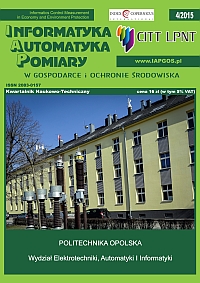THE INFLUENCE OF SIO2, TIO2 AND AL2O3 NANOPARTICLE ADDITIVES ON SELECTED PARAMETERS OF CONCRETE MIX AND SELF-COMPACTING CONCRETE
Article Sidebar
Open full text
Issue Vol. 5 No. 4 (2015)
-
DEPARTMENT OF ELECTRICAL, CONTROL AND COMPUTER ENGINEERING, OPOLE UNIVERSITY OF TECHNOLOGY – DEVELOPMENT AND NEW CHALLENGES
Marian Łukaniszyn, Jan Sadecki3-6
-
THE FUZZY SYSTEM FOR RECOGNITION AND CONTROL OF THE TWO PHASE GAS-LIQUID FLOWS
Paweł Fiderek, Radosław Wajman, Jacek Kucharski7-11
-
FUZZY CLUSTERING OF RAW THREE DIMENSIONAL TOMOGRAPHIC DATA FOR TWO-PHASE FLOWS RECOGNITION
Paweł Fiderek, Tomasz Jaworski, Radosław Wajman, Jacek Kucharski12-15
-
CREATING ALGORITHM FOR SIMULATION OF FORMING FLAT WORKPIECES
Konstantin Solomonov, Sergey Lezhnev16-19
-
SITE OF ACTIVE PARTICIPANT IN THE ELECTRICITY MARKET
Przemysław Wanat, Dariusz Bober20-25
-
WIRELESS SENSOR PHYSICAL ACTIVITY BASED ON LOW-POWER PROCESSOR
Rafał Borowiec, Wojciech Surtel26-31
-
APPLICATION CHAN-VESE METHODS IN MEDICAL IMAGE SEGMENTATION
Paweł Prokop32-37
-
EFFECT OF HIGH VOLTAGE ON THE DEVELOPMENT OF THE PLANT TISSUE
Eliška Hutová, Petr Marcoň, Karel Bartušek38-41
-
ENVIRONMENTAL APPLICATION OF ELECTRICAL DISCHARGE FOR OZONE TREATMENT OF SOIL
Tomoya Abiru, Fumiaki Mitsugi, Tomoaki Ikegami, Kenji Ebihara, Shin-ichi Aoqui, Kazuhiro Nagahama42-44
-
MASSIVE SIMULATIONS USING MAPREDUCE MODEL
Artur Krupa, Bartosz Sawicki45-47
-
EFFICIENT CONVERSION OF ENERGY IN THE CONDITIONS OF TRIGENERATION OF HEAT, COOLING AND ELECTRIC POWER
Nadzeya Viktarovich48-51
-
ISOTROPY ANALYSIS OF METAMATERIALS
Arnold Kalvach, Zsolt Szabó52-54
-
A CONTROL UNIT FOR A PULSED NQR-FFT SPECTROMETER
Andriy Samila, Alexander Khandozhko, Ivan Hryhorchak, Leonid Politans’kyy, Taras Kazemirskiy55-58
-
THE INFLUENCE OF SIO2, TIO2 AND AL2O3 NANOPARTICLE ADDITIVES ON SELECTED PARAMETERS OF CONCRETE MIX AND SELF-COMPACTING CONCRETE
Paweł Niewiadomski59-61
-
FREQUENCY DEPENDENCE OF THE MAGNETOELECTRIC VOLTAGE COEFFICIENT IN (BiFeO3)x-(BaTiO3)1-x CERAMICS
Tomasz Pikula, Karol Kowal, Piotr Guzdek62-69
-
HIGH TEMPERATURE ANNEALING INFLUENCE ON ELECTRIC PROPERTIES OF NANOCOMPOSITE (FeCoZr)81.8(CaF2)18.2
Vitalii Bondariev, Tomasz Kołtunowicz70-76
-
INTERROGATION SYSTEMS FOR MULTIPLEXED FIBER BRAGG SENSORS
Damian Harasim, Piotr Kisała77-84
-
APPLICATION OF SEMICONDUCTOR GAS SENSORS ARRAY FOR CONTINUOUS MONITORING OF SEWAGE TREATMENT PROCESS REGULARITY
Łukasz Guz85-91
-
THE MODEL OF OBJECTS’ SORTING PROCESS BY USING NEURO APPROACH
Jaroslav Lotysz92-98
Archives
-
Vol. 7 No. 4
2017-12-21 23
-
Vol. 7 No. 3
2017-09-30 24
-
Vol. 7 No. 2
2017-06-30 27
-
Vol. 7 No. 1
2017-03-03 33
-
Vol. 6 No. 4
2016-12-22 16
-
Vol. 6 No. 3
2016-08-08 18
-
Vol. 6 No. 2
2016-05-10 16
-
Vol. 6 No. 1
2016-02-04 16
-
Vol. 5 No. 4
2015-10-28 19
-
Vol. 5 No. 3
2015-09-02 17
-
Vol. 5 No. 2
2015-06-30 15
-
Vol. 5 No. 1
2015-03-31 18
-
Vol. 4 No. 4
2014-12-09 29
-
Vol. 4 No. 3
2014-09-26 22
-
Vol. 4 No. 2
2014-06-18 21
-
Vol. 4 No. 1
2014-03-12 19
-
Vol. 3 No. 4
2013-12-27 20
-
Vol. 3 No. 3
2013-07-24 13
-
Vol. 3 No. 2
2013-05-16 9
-
Vol. 3 No. 1
2013-02-14 11
Main Article Content
DOI
Authors
Abstract
The paper presents the results of own research on 10 series of self-compacting concrete which was modified with different amounts of SiO2, TiO2 and Al2O3 nanoparticle additives. The study included rheological properties of concrete mixes and mechanical properties of the hardened concrete in the form of compressive strength and bending strength. The obtained results are shown in relation to comparative concrete made without the addition of nanoparticles.
Keywords:
References
Abdoli Yazdi N., Arefi M.R., Mollaahmadi E., Abdollahi Nejand B.: To study the effect of adding Fe2O3 nanoparticles on the morphology properties and microstructure of cement mortar, Life Science Journal, 8(4), 2011, 550–554.
EFNARC The European Federation of Specialist Construction Chemicals and Concrete Systems, The European Guidlines for Self-Compacting Concrete. Specification, Production and Use., 2005.
Gaitero J. J., Campillo I., Mondal P., Shah S. P.: Small Changes Can Make a Great Difference, Transportation Research Record, 2141, 2010, 1–5.
Hui L., Hui-Gang X., Jie Y., Jin-ping O.: Microstructure of cement mortar with nanoparticles, Composites: Part B 35, 2004, 185–189.
Kurzydłowski K., Lewandowska M.: Engineering nanomaterials (in Polish), Wydawnictwo Naukowe PWN, Warsaw, 2011.
Mondal P., Shah S. P., Marks L. D., Gaitero J. J.: Comparative Study of the Effects of Microsilica and Nanosilica in Concrete, Transportation Research Record, 2141, 2010, 6–9.
Nazari A.: Computer-aided prediction of physical properties of high-strength concrete containing Fe2O3 nanoparticles (in Polish), Cement Wapno Beton, 5, 2012, 265–285.
Nazari A., Khalaj G., Riahi S., Khalaj M. J.: The influence of Al2O3 nanoparticles on the properties of traditional concrete with granulated blastfurnace slag as binder, Cement Wapno Beton, 6, 2011, 311–322.
Nazari A., Riahi S.: Abrasion resistance of concrete containing SiO2 and Al2O3 nanoparticles in different curing media, Energy and Buildings, 43, 2011, 2939–2946.
Nazari A., Riahi S.: Effects of CuO nanoparticles on compressive strength of self-compacting concrete, Sadhana, vol. 36, part 3, 2011, 371–391.
Nazari A., Riahi S.: Effect of TiO2 on properties of self-compacting concrete (in Polish), Cement Wapno Beton, 3, 2011, 167–181.
Nazari A., Riahi S.: The effects of Cr2O3 nanoparticles on strength assessments and water permeability of concrete in different curing media, Materials Science and Engineering A, 528, 2011, 1173–1182.
Nazari A., Riahi S.: The Effects of ZnO2 Nanoparticles on Properties of Concrete Using Ground Granulated Blast Furnace Slag as Binder, Materials Research, 14(3), 2011, 299–306.
Nazari A., Riahi S., Riahi S., Shamekhi S. F., Khademno A.: Influence of Al2O3 nanoparticles on the compressive strength and workability of blended concrete, Journal of American Science, 6(5), 2010, 6–9.
Shih J.-Y., Chang T.-P., Hsiao T.-C.: Effect of nanosilica on characterization of Portland cement composite, Materials Science and Engineering A, 424, 2006, 266–274.
Stankiewicz N., Lelusz M.: Nanotechnology in civil engineering – application review (in Polish), Civil and environmental engineering, 5, 2014, 101–112.
Article Details
Abstract views: 311
License

This work is licensed under a Creative Commons Attribution-ShareAlike 4.0 International License.






